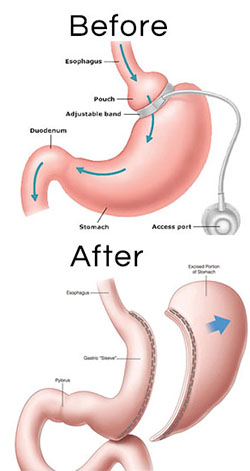 Lap-Band Revision Surgery Lap-Band Revision Surgery
Lap-Band Revision Surgery involves removal of the Lap Band and Conversion to Sleeve Gastrectomy
The majority of our Lap-Band ® patients have experienced successful weight loss with the Lap-Band gradually over time. The Lap-Band remains the safest, most effective, reversible surgical option for weight loss. However, some of our patients have experienced intolerance to the band with symptoms such as weight regain, band slippage, infection, severe heartburn, and other issues that have made long-term weight loss a challenge to achieve their individual weight loss goals.
For this reason, Dr Kuri has begun performing “Lap Band Revision Surgery” on select patients experiencing these types of issues. Lap Band Revision Surgery entails removal of the Lap-Band and surgical transition to the Gastric Sleeve.
If you have intolerance to the Lap-Band, removal of your band offers immediate symptom relief. However, without another bariatric procedure, most patients will regain weight after the band has been removed. Studies have shown that weight loss following revision to Gastric Sleeve Surgery as high as 60% compared to pre-band removal weight.
Laparoscopic Lap Band Removal
The Lap-Band is removed laparoscopically and is a relatively easy and safe operation depending on existing health issues.
The steps of a lap band removal surgery are as follows:
1. Insert laparoscopic instruments through small incisions. In most cases, the old incisions can be used.
2. Cut the scar tissue around the band.
3. Cut the tubing and band.
4. Pull out the band from around the stomach.
5. During the initial operation, the upper part of the stomach (fundus) is usually sutured to the part of the stomach above the band to prevent band migration. Some general surgeons tend to leave the adhesions and those sutures in place during the lap band removal operation. However, it is very important to remove those sutures and lyse the adhesions. This will restore the original anatomy of the stomach and make subsequent or later revisional surgery much easier.
6. After the band is removed, the perigastric capsule (dense scar tissue around the upper part of the stomach or esophagus) should be removed or incised to reduce the chance of obstruction after surgery.
7. The subcutaneous port is removed.
8. The surgeon will then proceed with the Gastric Sleeve surgery after the band is removed.
Lap Band Conversion to the Gastric Sleeve
Gastric Sleeve Surgery involves permanently removing a large portion of the stomach, anywhere from 60% to 85% of the total stomach. The portion left behind is a slim tube or “sleeve” that will serve as your new stomach. The remaining stomach looks like a sleeve (or hose or tube) and holds about 50 to 150ml. or about the size of a banana.
The Gastric Sleeve works by limiting the amount of food that can be eaten. In addition, it promotes weight loss by changing hormonal signals between the stomach, brain, and liver to establish a lower set point. As a result, fewer calories are absorbed into the body and the hormonal signals between the stomach and the brain are changed causing patients to feel less hungry. Consequently patients experience weight loss and improvement in overall health and well-being.
The overall health benefits of the Gastric Sleeve include:
- An average of 60% excess weight loss
- Over 70% of patients experienced improvement or remission of Type 2 Diabetes.
- Improved overall well-being, health, physical activity, and self confidence.
- Improvements in patients with high blood pressure, sleep apnea, and joint pain.
- Significant improvements in obesity-related health conditions such as Type 2 Diabetes, High Cholesterol, High Blood Pressure, and Sleep Apnea.
|